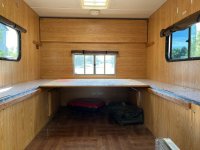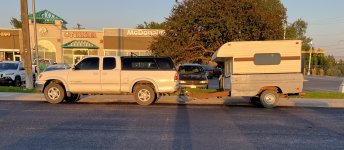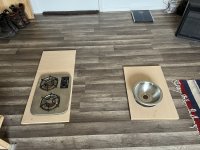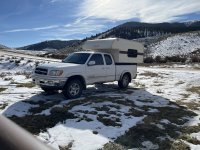MT-Camper
New member
Hey everyone. I'm still getting familiar with the forum and I apologize if this is obviously covered somewhere already. If you know of a thread or resource please point me toward it.
I bought this camper, a Teton Traveler (no longer in business) almost a year ago. It was a finished but empty shell.


I need a bit more comfort. I've built a dinette, and I'm in the process of adding a basic sink setup on one side, two-burner stovetop on the other. A previous owner had installed a catalytic Wave heater. They just drilled a hole in the side and fed a soft line straight from the regulator on the tank, to the heater.
Most things I can handle with my limited knowledge, but I've never built a propane system. I've worked on existing systems, but never built one.
It seems like soft propane lines are ok for exterior, but hard lines are recommended (required?) for interior. I just ordered 20' of 3/8" type L copper propane line, along with bending and flaring tools. I can handle that part. It's all the connections I'm unsure about. How do research and find what connector I need for the exterior soft line to interior hard line? Do the hard lines run through the wall, and the connection is outside the camper? How and where is that connection/transition made? Once I'm at the hard line, I'll need a Y or T. Just the two appliances. I think that Y happens inside the camper, not outside? I know I want to limit the joints inside, but it doesn't seem like I should be drilling two separate holes in the camper for the copper line running to each appliance.
I think I can contact Wave for the heater and Suburban for the gas cooktop to ask those companies what connectors to use from their appliances to my 3/8" hard copper line, but I'm unsure about the rest of the connections.
I really appreciate any insights...Seems like mostly what I'm asking for is advice on the soft to hard line and exterior to interior installation/transition/methods and connector/adaptors.



I bought this camper, a Teton Traveler (no longer in business) almost a year ago. It was a finished but empty shell.


I need a bit more comfort. I've built a dinette, and I'm in the process of adding a basic sink setup on one side, two-burner stovetop on the other. A previous owner had installed a catalytic Wave heater. They just drilled a hole in the side and fed a soft line straight from the regulator on the tank, to the heater.
Most things I can handle with my limited knowledge, but I've never built a propane system. I've worked on existing systems, but never built one.
It seems like soft propane lines are ok for exterior, but hard lines are recommended (required?) for interior. I just ordered 20' of 3/8" type L copper propane line, along with bending and flaring tools. I can handle that part. It's all the connections I'm unsure about. How do research and find what connector I need for the exterior soft line to interior hard line? Do the hard lines run through the wall, and the connection is outside the camper? How and where is that connection/transition made? Once I'm at the hard line, I'll need a Y or T. Just the two appliances. I think that Y happens inside the camper, not outside? I know I want to limit the joints inside, but it doesn't seem like I should be drilling two separate holes in the camper for the copper line running to each appliance.
I think I can contact Wave for the heater and Suburban for the gas cooktop to ask those companies what connectors to use from their appliances to my 3/8" hard copper line, but I'm unsure about the rest of the connections.
I really appreciate any insights...Seems like mostly what I'm asking for is advice on the soft to hard line and exterior to interior installation/transition/methods and connector/adaptors.



Last edited:



